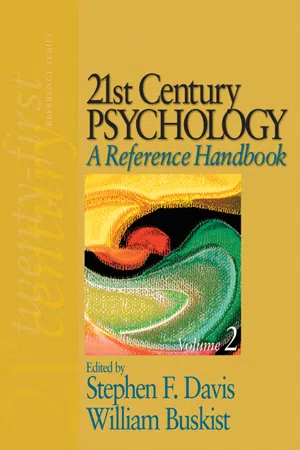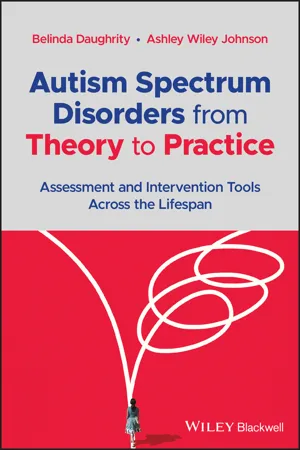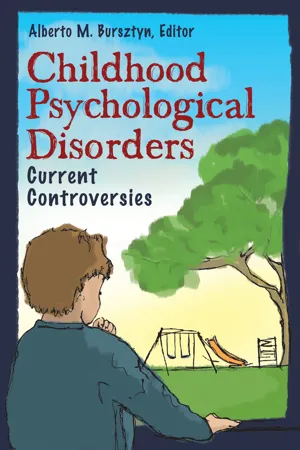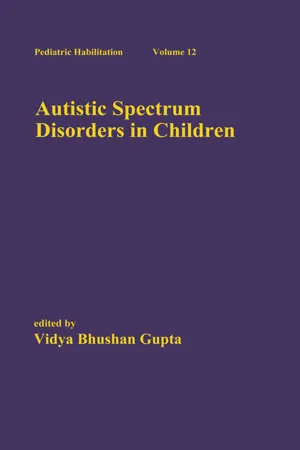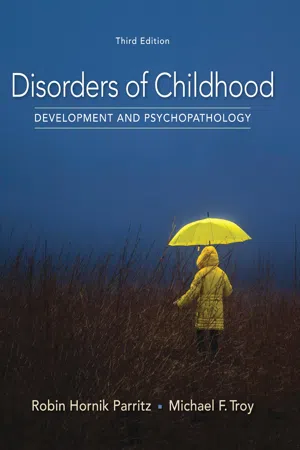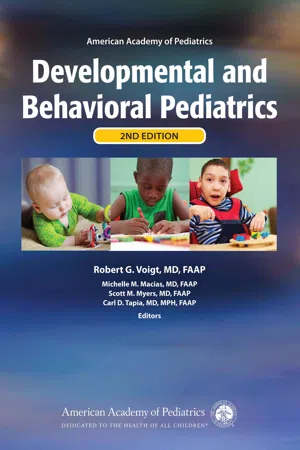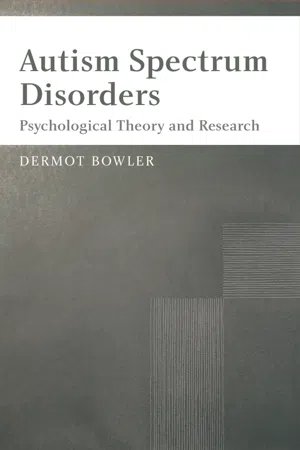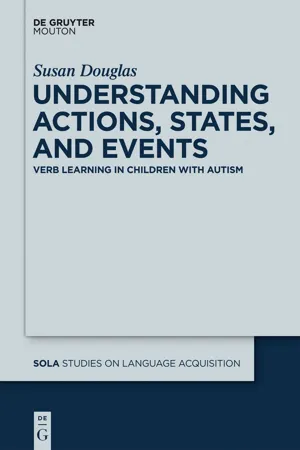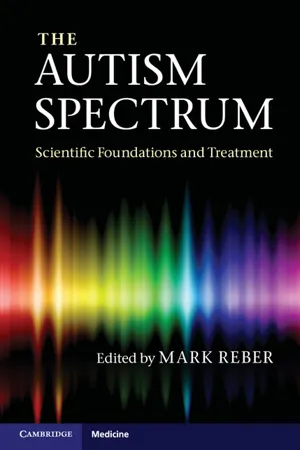Psychology
Autism
Autism is a neurodevelopmental disorder characterized by challenges in social interaction, communication, and repetitive behaviors. It is a spectrum disorder, meaning individuals with autism can have a wide range of symptoms and levels of impairment. While the exact cause of autism is not fully understood, it is believed to involve a combination of genetic and environmental factors.
Written by Perlego with AI-assistance
Related key terms
1 of 5
12 Key excerpts on "Autism"
- Stephen F. Davis, William Buskist, Stephen F. Davis, William F. Buskist(Authors)
- 2007(Publication Date)
- SAGE Publications, Inc(Publisher)
Through collaborative efforts of Janet’s pediatri-cian, the developmental clinical psychologist, and consulta-tions with a speech/language specialist, Janet was diagnosed with Autism at years and 10 months of age. The family is currently making arrangements for Janet to attend a developmental preschool that specializes in behav-ioral interventions for pervasive developmental disorders. Janet’s psychologist has informed the family that Janet’s prognosis is greatly improved due to their early recognition of problems and proactive responses to enroll her in special-ized behavioral services at a young age. However, the psy-chologist also indicated that each situation is specific to the client’s needs, and treatment and prognosis are dependent upon Janet’s needs and responses to the interventions. DEFINITION Autism, or autistic disorder, is a condition, typically diag-nosed in children prior to age three, in which an individual demonstrates significant impairment in communication abil-ities, social interactions, and a restricted repertoire of behav-ior, interest, and activities (American Psychiatric Association, 000). Historically, Autism has also been called early infan-tile Autism, childhood Autism, or Kanner’s Autism. Currently Autism is defined at three distinct but inter-dependent levels: as a neurological disorder related to brain development; as a psychological disorder of cognitive, emo-tional, and behavioral development; or as a relationship disor-der in which there is a failure of normal socialization (Kusch & Petermann, 1995). Autism falls within a cluster of disor-ders in which children demonstrate different variations of autistic-like characteristics or developmental complications. Autism • 47 This cluster of disorders is identified as the pervasive developmental disorders (PDD).- eBook - PDF
Autism Spectrum Disorders from Theory to Practice
Assessment and Intervention Tools Across the Lifespan
- Belinda Daughrity, Ashley Wiley Johnson(Authors)
- 2022(Publication Date)
- Wiley-Blackwell(Publisher)
Summary 13 SUMMARY ASD is a complex neurodevelopmental disorder that centers around social communi- cation challenges and includes the presence of restricted and repetitive behaviors. Causes of Autism include genetic and environmental factors, although the complete cause remains unknown. The DSM-IV had three diagnostic domains required to meet diagnostic criteria for diagnosis: restricted and/or repetitive behaviors, communica- tion, and social interaction challenges. The DSM-V reduced the diagnostic criteria to two domains and collapsed the domains of communication and social interaction to form the criteria of social communication. Current views support the idea of several disorders classified as an Autism spectrum rather than former separate diagnostic categories such as PDD-NOS and Asperger’s. Optimal treatment of ASD includes a collaborative approach between several disciplines with respective expertise. Treatment of ASD should focus on promoting communication and independence. The neurodi- versity movement offers a perspective that includes more acceptance of neurological variance. The voices of individuals with Autism should be included in their own care. This can be accomplished in part by valuing first-hand accounts, centering the scholarship of researchers with Autism, and reconceptualizing the ideas of Autism to prioritize strengths of individuals, rather than deficits. 14 Chapter 1 Historical Perspectives of Autism Spectrum Disorder REFLECTIONS ALONG THE PATH I began working with children with disabilities in the late 1970s/early 1980s. We were just starting to work with severely delayed children, who had limited services and support. I was very involved in Child Find efforts, because at the time, school- aged children with disabilities were not given an opportunity to attend public school programs. That changed in the late 1970s with the passage of PL 94-142 (the Education for All Handicapped Children Act of 1975). - Angela Williams(Author)
- 2019(Publication Date)
- Omnigraphics(Publisher)
Part One Overview of Autism Spectrum Disorder 3 Chapter 1 What Are Autism Spectrum Disorder and Autistic Disorder? What Is Autism Spectrum Disorder? Autism spectrum disorder (ASD) refers to a group of complex neu -rodevelopment disorders characterized by repetitive and characteristic patterns of behavior and difficulties with social communication and interaction. The symptoms are present from early childhood and affect daily functioning. The term “spectrum” refers to the wide range of symptoms, skills, and levels of disability in functioning that can occur in people with ASD. Some children and adults with ASD are fully able to perform all activities of daily living while others require substantial support to perform basic activities. The Diagnostic and Statistical Manual of Mental Disorders (DSM-5 ) includes Asperger syndrome (AS), childhood disintegrative disorder (CDD), and pervasive developmental disor -ders not otherwise specified (PDD-NOS) as part of ASD rather than as separate disorders. A diagnosis of ASD includes an assessment of intellectual disability and language impairment. This chapter includes text excerpted from “Autism Spectrum Disorder Fact Sheet,” National Institute of Neurological Disorders and Stroke (NINDS), October 10, 2018. 4 Autism and Pervasive Developmental Disorders Sourcebook, 4th Ed. ASD occurs in every racial and ethnic group, and across all socio-economic levels. However, boys are significantly more likely to develop ASD than girls. An analysis from the Centers for Disease Control and Prevention (CDC) estimates that 1 in 68 children has ASD. What Are Some Common Signs of Autism Spectrum Disorder? Even as infants, children with ASD may seem different, especially when compared to other children their own age. They may become overly focused on certain objects, rarely make eye contact, and fail to engage in typical babbling with their parents.- eBook - PDF
Childhood Psychological Disorders
Current Controversies
- Alberto M. Bursztyn Ph.D.(Author)
- 2011(Publication Date)
- Praeger(Publisher)
For some parents and individuals with these challenges, one diagnosis can be seen as more socially or personally acceptable than an- other. They may also be informed there are better services and supports for one diagnosis than for another. Any discussion of Autism needs to in- clude a clarification of the meaning of the various diagnostic labels in use, a process complicated by the fact that within the mental health field some of those labels are still contested. Defining Asperger Syndrome and Pervasive Developmental Disorders Consideration of Autism spectrum disorder and Asperger syndrome (AS) in particular has to take into account the nature of emerging understand- ings over the past decade during which there has been much productive work on brain function and neurophysiology. Yet, despite considerable advances, many questions and concerns still remain for parents of children with ASD or Asperger syndrome. Autism spectrum disorders, also re- ferred to as pervasive developmental disorders (PDD), are neurobiological or neurodevelopmental disorders. Current understanding suggests that there are distinct structural alterations in the brain that result in differences in processing and functioning of affected individuals as they develop. The ASD-PDD spectrum covers a broad continuum of social and behav- ioral functioning and cognitive skills, with varying degrees of three com- mon diagnostic characteristics: (1) a lack or delay in functional language Autism Spectrum Disorders 73 development and use, (2) a lack or significant compromise in the devel- opment of social relatedness with others (especially peers), and (3) signifi- cant repetitive behaviors or narrow areas of interest. A notable number of children also manifest some degree of sensory problems (i.e., intense sen- sitivity to noise, light, smells, touch and texture, or even to food). An ASD diagnosis implies a lifelong psychological disability. - eBook - PDF
- Vidya Bhushan Gupta(Author)
- 2004(Publication Date)
- CRC Press(Publisher)
In 1978, the professional advisory board of the National Society for Children and Adults with Autism defined Autism as a behavioral disorder that had the following characteristics: signs and symptoms prior to the age of 30 months, characteristic disturbances of developmental History, definition, and classification of autistic spectrum disorders 3 rate/sequence, characteristic disturbances of responsiveness to sensory stimuli, characteristic disturbances of speech, language, and cognitive capacities, and characteristic disturbances of relating to people, events, and objects (21). DSM-III followed through in resolving the confusion between Autism and schizophrenia by including Autism in the newly created category of pervasive developmental disorder (22). The term “pervasive” recognized that multiple domains of a child’s functioning are affected by Autism—social, communicative, and cognitive. DSM- III had four categories under pervasive developmental disorders: infantile Autism, childhood-onset Autism, atypical Autism, and residual Autism. Infantile Autism and childhood-onset Autism were differentiated by the age-of-onset criterion of 30 months. Because the age-of-onset criterion is dependent on age of recognition and not on the true age of onset, few cases of childhood-onset pervasive developmental disorder were described (23), DSM-IIIR replaced the category of infantile Autism with autistic disorder, removed the category of childhood-onset pervasive developmental disorder, and extended the age of onset to 36 months (24). It included all cases that did not meet the full criteria of autistic disorder in the category of pervasive developmental disorder, not otherwise specified and eliminated the categories of atypical and residual Autism. - eBook - PDF
Disorders of Childhood
Development and Psychopathology
- Robin Parritz, Michael Troy(Authors)
- 2017(Publication Date)
- Cengage Learning EMEA(Publisher)
This in turn leads to an emphasis on the idea of the child as a social being in a social world and the rec-ognition that this is of central importance throughout development. Autism Spectrum Disorder Autism spectrum disorder (ASD) is characterized by deficits and significant impairment in two domains: (1) social and communication deficits and (2) repeti-tive behaviors and fixated interests. For a diagnosis of Autism spectrum disorder, children, adolescents, or adults must display three kinds of social and commu-nication deficits: deficits in social–emotional reciproc-ity; deficits in nonverbal communication during social interactions; and deficits in developing and maintaining relationships. Each of these deficits is evaluated against developmental norms. In addition to these social and communication deficits, children must display at least two types of repetitive behaviors and fixated interests. These might include stereotyped or repetitive speech, motor movements, or use of objects; excessive adher-ence to routines or ritualized patterns or resistance to change; highly restricted interests that are atypical with respect to intensity or focus; or atypical sensitivity to sensory stimulation or atypical interest in aspects of the sensory environment. In addition to the core symptoms described in DSM-5, the level of severity of the symp-tom picture is noted, ranging from requiring support , to requiring substantial support , to requiring very substantial support . This severity index reflects the newly empha-sized dimensional conceptualization of Autism spec-trum disorder (see Table 7:1). The diagnostic criteria in DSM-5 are intended to capture “the similarities that do exist within the syndrome while recognizing the diverse ways that these core deficits can be manifested” (Lord & Bishop, 2015, p, 57). These broader domains also help clinicians and researchers track continuity or change across development. - eBook - PDF
Group Interventions for Children with Autism Spectrum Disorders
A Focus on Social Competency and Social Skills
- Albert Cotugno(Author)
- 2009(Publication Date)
- Jessica Kingsley Publishers(Publisher)
PART I Autism SPECTRUM DISORDERS (ASD) Do not be anxious about tomorrow, For tomorrow will be anxious for itself. Matthew, 6:34 Part I provides a brief introduction to ASD and how it relates to the approach described in this book. Current definitions are presented in order to under-stand the range of thinking (and controversy) that continues to exist and influence the field as intervention models are sought. Next a broad historical perspective is presented to trace and to under-stand the path that ASD diagnoses have traveled and how we have arrived at our current state of understanding. Additional definitions of ASD are also briefly presented to provide the broadest understanding of the diagnostic issues that are currently being addressed. Last in Part I, since ASD is primarily a social disorder for many individu-als on the spectrum, an understanding of social development is considered critical, particularly as it relates to the treatment and management of the social deficits observed in ASD individuals. Social development as it relates to both typical and ASD individuals is described and later considered within the group-focused, peer-based, cognitive-developmental stage model described in this book. Chapter 1 Introduction Autism Spectrum Disorders (ASD) are a group of neurologically-based disorders which significantly affect development in social, behavioral, and language/communication areas. ASD includes the diagnoses of Autistic Disorder (AuD), Asperger’s Disorder (AD), and Pervasive Developmental Disorder-Not Otherwise Specified (PDD-NOS) and are considered to be part of the global category of Pervasive Developmental Disorders (PDD), due to their extensive, pervasive, and debilitating effects on the particular areas affected. - eBook - PDF
- AAP Section on Developmental and Behavioral Pediatrics, Robert G. Voigt, Robert G. Voigt(Authors)
- 2018(Publication Date)
- American Academy of Pediatrics(Publisher)
4. Hyper- or hypo-reactivity to sensory input or unusual interests in sensory aspects of the environ-ment (e.g., apparent indifference to pain/temperature, adverse response to specific sounds or textures, excessive smelling or touching of objects, visual fascination with lights or movement). Specify current severity : Severity is based on social communication impairments and restricted, repetitive patterns of behavior (see Box 19.2). C. Symptoms must be present in the early developmental period (but may not become fully manifest until social demands exceed limited capacities, or may be masked by learned strategies in later life). D. Symptoms cause clinically significant impairment in social, occupational, or other important areas of current functioning. E. These disturbances are not better explained by intellectual disability (intellectual developmental disorder) or global developmental delay. Intellectual disability and Autism spectrum disorder frequently co-occur; to make comorbid diagnoses of Autism spectrum disorder and intellectual disability, social communication should be below that expected for general developmental level. Note: Individuals with a well-established DSM-IV diagnosis of autistic disorder, Asperger’s disorder, or pervasive developmental disorder not otherwise specified should be given the diagnosis of Autism spectrum disorder. Individuals who have marked deficits in social communication, but whose symptoms do not otherwise meet criteria for Autism spectrum disorder, should be evaluated for social (pragmatic) communication disorder. - eBook - PDF
Autism Spectrum Disorders
Psychological Theory and Research
- Dermot Bowler(Author)
- 2006(Publication Date)
- Wiley(Publisher)
There is much we do not under-stand about how psychological development comes about, and what mecha-nisms underlie particular patterns of overt behaviour. In the current state of knowledge, it is perhaps premature to leap from the patterning of behav-ioural trajectories to underlying processes to the consequences of intervention. CONCLUSION The concept of ASD as a set of different developmental trajectories that com-promise an individual’s interpersonal relations and tend to produce behaviour that is rigid and repetitive has evolved considerably over the last five decades. It is now accepted that there is a spectrum of conditions, the most commonly occurring of which are (in DSM terminology), autistic disorder, Asperger dis-order and PDD-NOS. Although individuals can readily be identified who fit the criteria for each of these conditions, the boundaries between the categories are not always clear, and assigning a particular individual to one or other cat-egory is often a matter of judgment, which like all human judgment is prone to error. Nevertheless, we can provisionally conclude that there exists in nature a group of individuals whose development differs from the typical trajectory in that they experience particular kinds of difficulties in relating to and under-standing other people and who have impoverished imagination and a behav-ioural repertoire that tends to be repetitive and stereotyped in nature. The trajectory may or may not be accompanied by global intellectual impairment, which can range from mild to profound. The combination of social and cog-nitive impairment may inhibit the development of verbal communication, but even in non-intellectually disabled individuals, language and communication are marked by particular characteristics. Thus we have a basis for the work that will be described in the rest of this book; we have a natural phenomenon that we can attempt to explain. IDENTIFYING Autism 25 - eBook - PDF
Early Intervention for Autism Spectrum Disorders
A Critical Analysis
- Johnny L. Matson, Noha F. Minshawi(Authors)
- 2006(Publication Date)
- Elsevier Science(Publisher)
Geneva: World Health Organization. Reprinted with permission. b From Diagnostic and Statistical Manual of Mental Disorders, Fourth Edition, Text Revision (p. 77), by American Psychiatric Association, 2000. Washington, DC: American Psychiatric Association. Copyright 2000 by the American Psychiatric Association. Reprinted with permission. 14 Early Intervention for Autism Spectrum Disorders Autism Spectrum Disorders The idea of Autism existing not as a single entity, but as a spectrum along which there are multiple disorders of varying severity, emerged in the late 1990s and has recently taken hold in the literature and popular culture. At this time, researchers and clinicians began to refer to these conditions as Autism Spectrum Disorders (ASD). For the most part, we will use the term ASD in reference to these disorders for the remainder of this book. The triad of behaviors believed to underlie Autism Spectrum Disorders is made up of impairments in social interaction, impairments in communication, and narrow, repetitive patterns of behavior (Wing, 1997). Developers of both ICD-10 (WHO, 1996) and DSM-IV (APA, 1994) have attempted to divide Autism Spectrum Disorders into categories of Per-vasive Developmental Disorders (PDD), including Autistic Disorder, Asperger’s Syndrome (AS) and PDD not otherwise specified (PDD-NOS). However, as already discussed, the attempts at differentiating between these disorders have been, in Wing’s (1997) words, “arbitrary difficult to apply and unhelpful in clinical practice” (p. 1761). Both ICD-10 and DSM-IV have attempted to differentiate Autism and AS based on developmental history, cognitive functioning, and age of onset. However, research has failed to fully support these factors as clear methods of differential diagnosis (Wing, 1981). The DSM-IV (APA, 1994) uses the term PDD in place of ASD. - eBook - PDF
Understanding Actions, States, and Events
Verb Learning in Children with Autism
- Susan Douglas(Author)
- 2012(Publication Date)
- De Gruyter Mouton(Publisher)
In contrast, children with Autism tend to perform most poorly on tasks which require a verbal response. While short-term memory tasks yield higher results, the Comprehension subtest (WISC) in which participants are required to answer questions about social knowledge is one which children with Autism find particularly challenging (Green et al. 1995: 15). Nonetheless, the poor performance on communication tasks cannot simply be explained in terms of language impairment: studies comparing the performance levels of children with Autism in relation to children with specific developmental receptive language disorder found that the weakness in verbal competence observable in children with Autism is not attributable to a language disorder (Bartak, Rutter, and Cox 1975). Moreover, children with Autism are well able to articulate information on topics they know well when questioned (Frith 1989: 88). The cognitive profile obtained for individuals with Autism is strongly indicative of a neurological disorder and, although there is heterogeneity within the autistic population, the pattern is unique to the syndrome. Autism: The current perspective 27 Figure 1. Example from the Block Design Test Reproduced with kind permission from U. Frith (2003) Autism: Explaining the Enigma, 2 nd Edition (Oxford: Blackwell), p.156 One of the major psychological theories of Autism to emerge over the last two decades as an explanation for the uneven cognitive development of individuals with Autism is the claim that they lack a theory of mind. The phrase “theory of mind” originated from the work of Premack and Woodruff (1978) and is defined as the ability to conceive of mental states or, to attribute thoughts and emotions to others. This capacity to recognize that others have mental states different from our own is known as metarepresentation. - eBook - PDF
The Autism Spectrum
Scientific Foundations and Treatment
- Mark Reber(Author)
- 2012(Publication Date)
- Cambridge University Press(Publisher)
Whatever the ultimate fate of “Asperger’s syndrome” as a diagnostic entity, it has, like “autistic disorder,” a rich clinical history and has been the subject of fruitful investigation. It is a term that will likely continue to be used by patients, families, and caregiving providers for a long time. Pervasive developmental disorder, NOS Wing and Gould’s 1979 Camberwell study and Wing’s 1981 discussion of Asperger’s syndrome raised awareness of conditions that shared with autistic disorder a central feature of severe deviations in the development of social reciprocity, but differed from it in the quality of social impairment or in the severity of other features of the autistic triad. In 1980, DSM-III introduced the diagnostic category of atypical pervasive developmental disorder for children with autistic-like features who did not meet the criteria for infantile Autism. DSM-III-R (1987) conferred upon these children the diagnosis pervasive developmental disorder, not otherwise specified (PDD-NOS). This term was retained in DSM-IV (1994), but three specifically named PDDs – Asperger’s disorder, Rett’s disorder, and childhood dis- integrated disorder – were removed from the category. Another important change in DSM- IV (1994) was a departure from the requirement that deficits in social interaction are necessary for the diagnosis. Significant impairment in any two of the three dimensions of the autistic triad were deemed sufficient. Thus, a child could be diagnosed with PDD-NOS if he had impaired verbal or nonverbal communication skills and repetitive, restricted or stereotyped behaviors, interests, and activities, without significant deficits in social interac- tion. This approach had the effect of broadening the category of PDD-NOS, and was changed in DSM-IV-TR (APA, 2000).
Index pages curate the most relevant extracts from our library of academic textbooks. They’ve been created using an in-house natural language model (NLM), each adding context and meaning to key research topics.
